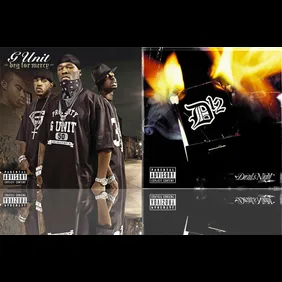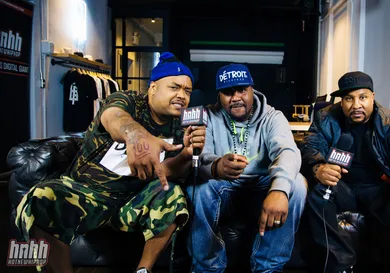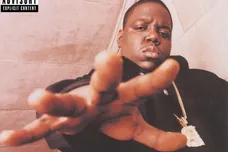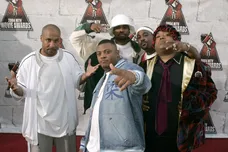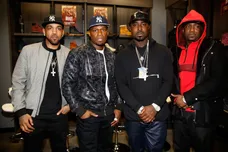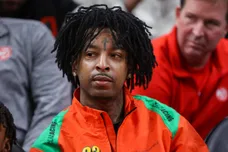During the early two-thousands, there came a time when every A-list rapper had to have a crew. In fact, it was almost mandatory. DMX had Ruff Ryders. Ludacris has Disturbing Tha Peace. Nelly had The St. Lunatics. Eminem had D12, and 50 Cent had G-Unit. The latter two are the centerpiece of this week’s feature, and both share a common musical thread, as foundational pieces of the Shady/Aftermath empire. D12’s Devil’s Night and G-Unit’s Beg For Mercy both emerged as their respective ringleaders were enjoying their commercial and critical peak.
For some context, Devil’s Night was Em’s followup project to The Marshall Mathers LP, and Beg For Mercy came after 50 Cent dropped The Massacre. We’re talking two of the biggest artists in the world, linking up with some of the homies for high-profile studio albums. In the case of the Dirty Dozen, a simplified variation of the origin story tells a tale of six young emcees from Detroit, who made a pact - the first one to blow up would return for the others, and go on to make history. And like any true origin story, there is at once tragedy and triumph.
On May 21st, 1999, one of the founding members, Bugz, was sadly murdered in a violent altercation. Despite that, Eminem went on to explode into a near-overnight celebrity, and ultimately kept his word. And thus, D12 was born, the brainchild of Eminem, Proof, Kon Artis, Kuniva, Bizarre, and Swift Mcvay. On the Marshall Mathers LP 2 bonus cut “Groundhog Day,” Em breaks down the process - “started a group of misfits, Proof had a proposition, If we all band together, there ain't no stoppin' this shit, come up with aliases.” And thus, six emcees became twelve, as each member developed an alter-ego, each one more twisted than the next.
And while D12’s music was notoriously seeped in violence, there was a stark contrast in the violent world inhabited by 50 Cent, Lloyd Banks, Young Buck, and Tony Yayo. Where D12 opted for an exaggerated, near-cartoonish level of gleeful horror, G-Unit’s depiction of violence was that of an urban reality. In fact, violence quickly became part of the Unit’s mythos, as the public familiarized themselves with the legendary lore surrounding 50 Cent. Shot nine times and still breathing; a real life Luke Cage. It’s no wonder that G-Unit’s music remained gangsta to the core, with the lifestyle permeating their debut from the title, to the album cover, to the lyrical content.
So once again, the parallels between both groups are there. Both groups were made up of the hometown homies, and both featured a wildly successful “leading man.” Both featured involvement from both Eminem and Dr. Dre, and both went on to be commercial successes. Both pissed off a hell of a lot of parents, and both celebrated a world of violence, gunfire, weed, liquor, sex, and death. So, at the end of the day, are you riding with The Dirty Dozen and Devil’s Night, or G-Unit’s Beg For Mercy?
Production
On paper, G-Unit’s project boasts a more diverse lineup of producers, enlisting the skills of Hi-Tek, Dr. Dre, Eminem, Mr. Porter (D12’s Kon Artis), Red Spyda, Jake One, No I.D., Nottz, Sha Monely XL, and more. Over the course of eighteen tracks, Beg For Mercy’s production manages to feel unified in spite of the varied contributors. There are forays into Dr. Dre and Eminem’s gothic underworld, with “G’d Up” and “My Buddy” respectively. There are moments of restrained menace, like Hi-Tek’s “Eye For An Eye,” and moments of emotional sincerity on Red Spyda’s “Wanna Get To Know You.” It’s through the production that one of the album’s most notable differences can be felt; by comparison, Devil’s Night never quite leaves the “darker” side of the spectrum, and that’s largely a conscious production choice.
When it comes to Beg For Mercy’s most standout beats, it’s hard to argue against Dr. Dre’s dual contributions. “Poppin’ Them Thangs,” and “G’d Up” found Dre reunited with his 2001 collaborator Scott Storch, and together, they helped pioneer a unique brand of minor-key piano street banger. In fact, it can be argued that Scott Storch helped bring out some of Dre’s best work, and their music on Beg For Mercy is a testament to that fact. Hi-Tek’s “G-Unit” also deserves a shout-out, with a militant drumline, droning piano riff, and creeping bassline.
Where Beg For Mercy excels in enlisting an eclectic array of producers, Devil’s Night operates on a more in-house scale. Dr. Dre, Eminem, and Mr. Porter handle the bulk of the instrumental work, with the former contributing some of his most rock-inspired production to the cause. While Em’s production can be hit or miss, his work on Devil’s Night is solid, perfectly in keeping with the album’s lyrical themes. Beats like the haunting “American Psycho” find Em mastering the subtlety of atmosphere, and “Pimp Like Me,” has an eerie bounce you’d never expect from Marshall Mathers.
It would be remiss to neglect Dre’s contributions, which include “Nasty Mind,” “Ain’t Nuthin’ But Music,” “Fight Music,” and the Pink Floyd inspired “Revelation.” The latter two provide some of the album’s most anthemic music, encapsulating the pent up aggression and angst that the majority of D12’s core fanbase might have been feeling at the time. “Revelation” finds Dr. Dre in uncharacteristic territory, bringing out the electric guitars in full force, but keeping things grounded with his signature production. However, Devil`s Night’s production highlights tend to come from Eminem, who excels on “American Psycho,” “Purple Pills,” and “Pimp Like Me.”
Lyricism
The main issue with D12 and their work on Devil’s Night, was that it lacked any thematic diversity. While rappers like Proof, Swift, Kuniva, and Kon Artis were capable rhymers on a technical level, they often operated in a similar lyrical space on every song - sex without intimacy, drugs with reckless abandon, and murder without mercy. Swift tended to excel at spinning creative new ways to murder you, but he also never strayed too far from his comfort zone. Bizarre seemed more focused on horrifying listeners, with gems like “my girlfriend had a miscarriage, I had to eat it,” and “you know why my hands are so numb? Cause my grandmother sucked my dick and I didn’t come.”
Incest, rape, and even beastiality were never taboo subjects for Bizarre, who no doubt had young listeners feeling at once edgy, disgusted, and empowered. Yet lyrically, he too tended to operate within the confines of his limited comfort zone, and sometimes his verses felt like they existed for the sole purpose of shock value. Kuniva, Kon Artis, and especially the late Proof fared a little better when it came down to lyrical content, but ultimately, the Dirty Dozen really seemed to embrace their mission statement of murder, murder, and more murder. When they do branch out, like the conceptually driven “That’s How,” or the playful “Ain’t Nothin’ But Music,” the group’s off kilter sense of humor truly manages to shine through the darkness.
Devil’s Night also marks an interesting point in Eminem’s career, and many of his verses on this project are among his craziest work. He absolutely destroys tracks like “Shit Can Happen,” “American Psycho,” “Purple Pills,” and “Fight Music,” and his voice, flow, and lyrics are arguably at their deadliest:
“Picture me sitting in a jail cell rotting (Shit!!)
Or barricaded in a motel with twelve shotguns
So when the cops come knocking each hand's got one
Cocked, ready to dump slugs heavy as shotputs
One man army, guns can't harm me
Young and ornery, worse than my Uncle Ronnie”
As for G-Unit, 50-Cent always managed to stand out as a better-than-average lyricist, who never reached Em’s peak, but remained imaginative, clever, and creative enough to consistently entertain. His fellow crew member Lloyd Banks, on the other hand, was unrelenting in his bars, carving out a spot among the most formidable mixtape rappers of the era. His punchlines in particular were ridiculous, and his reputation for murdering freestyles ultimately raised the bar for his later studio work.
However, the more structured song format on Beg For Mercy meant Banks had less space to spaz out; instead, he was forced to adapt to the song’s message, which in turn led to verses that felt a little “Banks-lite.” When people were so accustomed to hearing the punchline king, did they really want to hear all the ways he might be able to make his lover smile? Regardless, Beg For Mercy should have unleashed Lloyd Banks the same way that Devil’s Night unleashed Slim Shady. That’s not to say that Banks’ efforts are weak, but one can only wonder if Banks was limited by the collaborative nature of the project.
In fact, it’s hard not to look at Young Buck as the project’s MVP. While many wondered how he would acquaint himself in the wake of Tony Yayo’s prison stint, Buck made himself at home on G-Unit’s debut, adding a welcome Southern perspective to the affair. His drawl-heavy delivery shined on the aforementioned “G-Unit,” where he kicks off the album with the project’s opening verse:
“Vacate ya home, I come to break ya bones
America's nightmare, we at it again
A Desert Eagle and a black Mac-10
They'll never know what happened
When we come through, them cowards don't want none
They screaming that they murderers, but walkin' with no guns”
G-Unit harbors no illusions about what sort of music they provide - gangster rap. Luckily, each emcee is skilled enough to carry a track, and 50, Banks, and Buck all enjoy their respective moments in the spotlight. Unlike D12, who tends to operate under a bit of a skill hierarchy, it’s always interesting to see which of the Unit comes through with the illest verse. And while 50 hardly delivers the same level of tour-de-force performance as Devil’s Night quarterback Eminem, his charisma and leadership are still felt throughout the entirety of Beg For Mercy.
Impact
Despite the lofty heights of their debuts, both D12 and G-Unit never really managed to meet their expectations on subsequent efforts. D12’s sophomore project D12 World did find the crew branching into new creative territory, but Em was on the beginning of his drug-fuelled downward spiral, and was no longer guaranteed to come through with a highlight verse. After D12 World dropped, the group was once again struck with tragedy - in 2006, Proof was murdered in a Detroit nightclub, and D12 as we knew it ceased to exist.
G-Unit, in some ways, was destroyed from the inside. After the addition and subsequent nuclear fallout with The Game, Young Buck and 50 found their partnership on edge, which led to yet another inter-squad beef. Their sophomore project, Terminate On Sight, came out five years after Beg For Mercy, and was nowhere near as good. After a hell of a run, the G-Unit era seemed to be at an end. The group has recently gone through a few revivals, but their heydey is behind them. In the end, however, their legacy will be immortalized by the strength of their timeless debut.
So, which album are you rolling with this week? Is it D12’s Devil’s Night, or G-Unit’s Beg For Mercy?
G-Unit & D12
